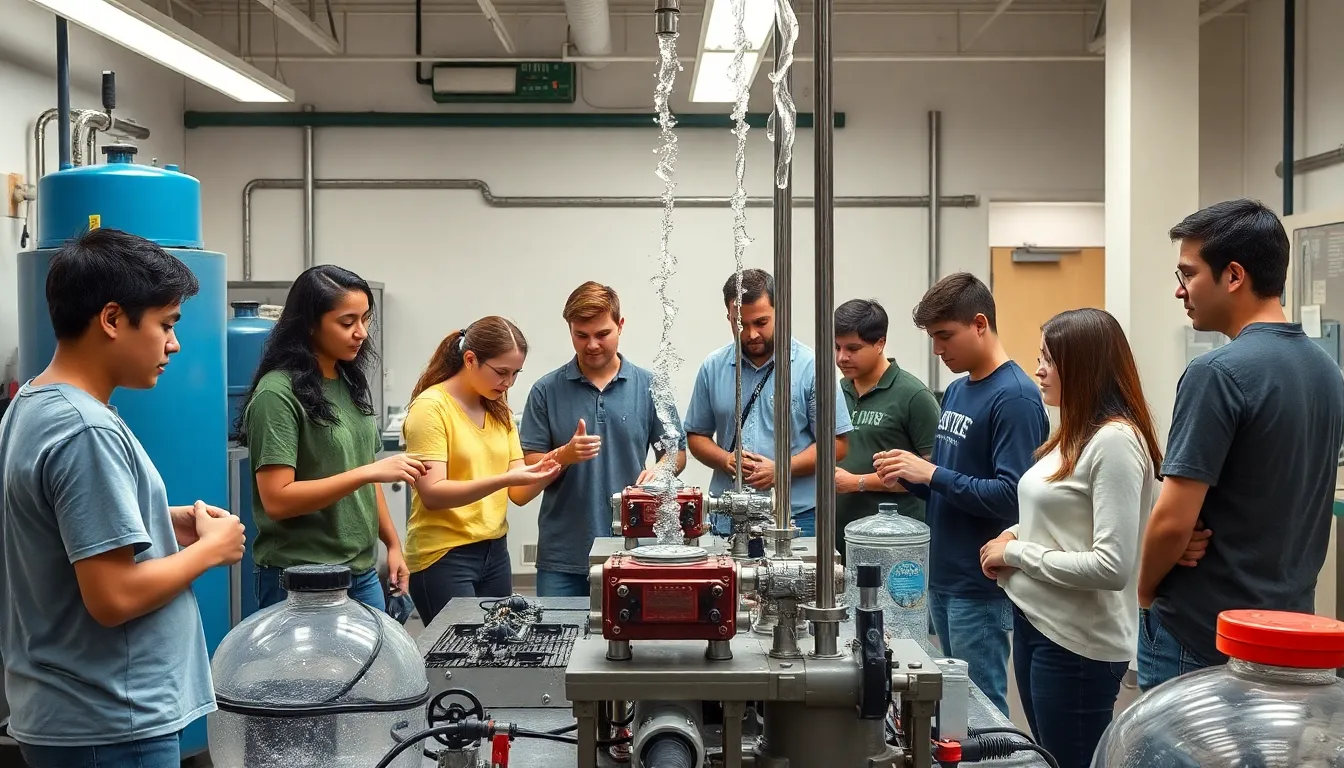Hydraulics experiments might sound like a snooze-fest, but they’re anything but! Imagine unleashing the power of water to lift, push, and move things around like a magician with a wand. From water rockets to hydraulic lifts, these experiments reveal the fascinating world of fluid mechanics in a way that’s not just educational but downright fun.
Table of Contents
ToggleOverview Of Hydraulics Experiments
Hydraulics experiments explore fluid mechanics principles through engaging activities. These experiments illustrate how fluids behave under pressure and demonstrate their real-world applications. Water rockets serve as a thrilling example, showcasing propulsion techniques powered by pressurized water.
Hydraulic lifts highlight the capability of fluids to transmit force. This type of experiment typically involves compressing a liquid in a small chamber, which subsequently raises a larger object in another chamber. Many students benefit from hands-on experience during these experiments, enhancing their understanding of basic physics concepts.
Demonstrations often utilize simple apparatus, such as syringes or tubes. These materials help to visualize concepts like Pascal’s principle, which states that pressure applied to a confined fluid is transmitted equally throughout the fluid. Engaging with these experiments can ignite a passion for science, fostering critical thinking skills.
Another common experiment involves building a mini-waterwheel, which illustrates the conversion of fluid energy into mechanical energy. Participants can observe how water flow creates movement, encouraging creativity in engineering and design.
Group activities in classrooms promote collaboration and discussion among students. Each individual contributes unique perspectives, enriching the learning experience. Teachers often guide students to hypothesize, test, and refine their experiments, providing a deeper understanding of hydraulic systems.
Ultimately, hydraulics experiments connect theoretical knowledge to practical applications, equipping students with vital skills for future studies in engineering and technology. By immersing themselves in these activities, students gain hands-on experience that solidifies their understanding of mechanics while sparking curiosity about scientific exploration.
Importance Of Hydraulics Experiments

Hydraulics experiments play a crucial role in understanding fluid mechanics. They provide hands-on learning opportunities for students, allowing them to explore the principles through practical applications.
Applications In Engineering
Engineering relies on hydraulics for various systems. Hydraulic lifts demonstrate the ability to lift heavy loads efficiently. Water-powered machinery showcases how fluid mechanics applies in real-world scenarios. Engineers utilize knowledge from hydraulics to design bridges, dams, and elevators. Understanding these concepts enables the development of innovative technologies in transportation and construction. Experimenting with hydraulic systems encourages creativity and problem-solving skills, essential for future engineers.
Impact On Environmental Studies
Hydraulic experiments influence environmental studies significantly. They illustrate the movement of water in ecosystems, affecting plant and animal life. By observing water flow, students learn about erosion and sediment transportation, emphasizing conservation. Experiments also highlight the importance of sustainable practices in freshwater management. Understanding hydraulic principles leads to better solutions for water resource challenges. Engaging in these experiments cultivates awareness of ecological impacts, fostering responsible stewardship of the environment.
Types Of Hydraulics Experiments
Hydraulics experiments fall into various types, each showcasing different principles of fluid mechanics. These experiments encourage students to explore essential concepts through hands-on activities.
Fluid Flow Experiments
Fluid flow experiments focus on observing how liquids move through different channels and obstacles. Students can use simple materials like tubes and containers to investigate flow rate and velocity. Activities such as creating water ramps demonstrate how elevation impacts speed. Another engaging experiment involves experimenting with different fluids, examining viscosity’s effect on flow behavior. Analyzing these factors helps students understand turbulent versus laminar flow. These comparisons foster a deeper grasp of how fluids interact with their environment.
Pressure Measurement Experiments
Pressure measurement experiments allow students to quantify the force exerted by fluid. Utilizing manometers or pressure gauges, they can measure how pressure varies with depth or flow rate. For example, students might explore how a submerged object experiences increased pressure at greater depths. Experimenting with Pascal’s principle shows how pressure transmits equally in all directions within a fluid. These practical applications emphasize the importance of pressure in hydraulic systems. Understanding these concepts builds a foundation for complex hydraulic engineering applications.
Methodologies In Hydraulics Experiments
Hydraulics experiments utilize various methodologies to effectively demonstrate key principles of fluid mechanics. Through these approaches, students gain hands-on experience, enhancing their understanding of hydraulic systems.
Experimental Design
Experimental design serves as the foundation for effective hydraulics experiments. Each design encourages students to formulate hypotheses, identify variables, and establish control measures. Water rockets and hydraulic lifts often feature as primary examples. By constructing these systems, students learn to analyze fluid behavior under different scenarios, observing how pressure influences motion. Engaging in group activities stimulates collaboration. Students can brainstorm and refine their designs, fostering a creative environment. Ultimately, thoughtful experimental design lays the groundwork for meaningful discoveries in hydraulic principles.
Data Collection Techniques
Data collection techniques are integral to understanding fluid dynamics in hydraulics experiments. Measurement tools like flowmeters and pressure gauges enable quantitative assessments of fluid behaviors. Students measure variables such as flow rate, fluid velocity, and pressure differences throughout their experiments. Recording these data points allows for accurate analysis and conclusions. Using charting software can enhance data visualization, aiding in interpretation and comprehension. Additionally, analyzing results fosters critical thinking skills, reinforcing connections between theoretical concepts and practical applications of hydraulics. These techniques enhance the learning experience, ensuring students grasp the complexities of fluid mechanics.
Challenges In Conducting Hydraulics Experiments
Conducting hydraulics experiments presents several challenges that can affect learning and outcomes.
Equipment Limitations
Equipment selection impacts the accuracy of experiments. Inadequate tools can lead to inaccurate measurements. Common issues include outdated or malfunctioning devices that do not provide reliable data. Students may also face limitations in available materials, restricting the complexity of their experiments. Insufficient fluid dynamics modeling equipment can hinder their ability to visually comprehend intricate concepts. Moreover, protective gear remains essential to ensure safety during experiments. Proper equipment and materials contribute significantly to successful hydraulics experimentation.
Interpretation Of Results
Interpreting results requires careful analysis. Students might struggle to understand data trends if they lack foundational knowledge in fluid mechanics. Data can appear misleading without a proper context, complicating the identification of relationships between variables. Additionally, drawing conclusions from results necessitates logical reasoning to connect observations with theory. Inaccurate interpretations could lead to misconceptions about fluid behavior. Critical thinking skills play a vital role in effectively analyzing experiment results. Overall, correctly interpreting data strengthens comprehension of hydraulic principles, enhancing the educational experience.
Hydraulics experiments serve as a powerful tool for engaging students in the principles of fluid mechanics. By providing hands-on learning experiences they spark curiosity and creativity. These experiments not only connect theoretical knowledge to real-world applications but also foster critical thinking and problem-solving skills.
As students explore concepts like fluid flow and pressure measurement they gain valuable insights into the behavior of liquids. The collaborative nature of these activities encourages discussion and teamwork, enriching the educational experience.
Ultimately hydraulics experiments cultivate a deeper understanding of engineering principles while promoting environmental awareness. Through these explorations students are better equipped to tackle future challenges in technology and sustainability.






